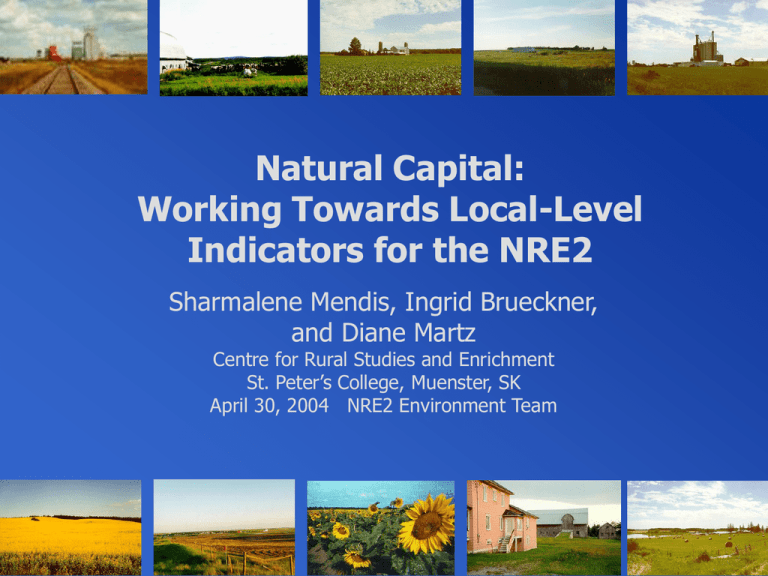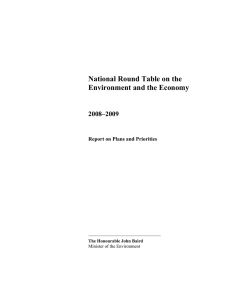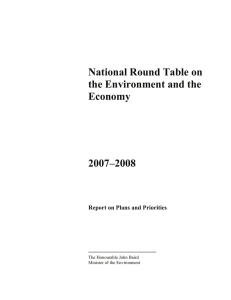Natural Capital: Working Towards Local
advertisement

Natural Capital: Working Towards Local-Level Indicators for the NRE2 Sharmalene Mendis, Ingrid Brueckner, and Diane Martz Centre for Rural Studies and Enrichment St. Peter’s College, Muenster, SK April 30, 2004 NRE2 Environment Team Overview Purpose and Goal Natural Capital Definition Scale Arguments Working Framework Indicators Definition Sample Criteria and Rationale What we plan to do Conclusion and Discussion Question for discussion: What is the relationship of NC with: Governance? Services? Communication? Ecosystems Human Systems Therefore… Ecosystem Wellbeing Human Wellbeing How to measure? Market Associative Bureaucratic Mobilizers Changes in and existence of the capitals Cultural values Community capacity Communal Social capital Natural capital Individual traits Community commitment Collective Outcome Human capital Economic /built capital Purpose and Goal Purpose To identify: A working definition of Natural Capital (NC) A framework of NC for communities Potential indicators accessible to community residents Appropriate and affordable local-level measures of NC Goal Identify indicators applicable at the local-level to measure the quantity and quality of NC Definition: Natural Capital Natural capital (NC) The natural endowments of a specified area that consists of stocks of environmental assets, with value embedded in their existence. These stocks yield a flow of goods and services now and into the future, which can combine with economic/built, human and social/cultural capitals to produce wellbeing. – Cahill, 2001; Flora, 1999; Folke and Berkes, 1998; MacDonald et al., 1999; Mendis et al.,2003; Olewiler, 2002; Pretty, 2004; Roseland, 2000; Smith,2000 Three Principle Categories of NC Natural Resources The stock of renewable and non-renewable resources the source of raw materials used in the production of manufactured goods Land essential for the provision of space in which economic activity and terrestrial ecosystems functioning may take place Ecosystem Services essential for the services they provide directly and indirectly to the economy and for ecosystem functioning. • Assimilative capacity • Life support functions • Amenities Application at Different Scales Global Prescott-Allen, 2001 National National Round Table for the Environment and the Economy (NRTEE) Provincial GPI Atlantic; Pembina Institute (Alberta); Prescott-Allen, 2002; Michalos, 1997 Local Parkins et al., 2001; Beckley et al., 2002; Shaw et al., 2002 Arguments Against the Use of NC Cannot adequately measure environment in monetary terms Traditional economic concept of capital is not comparable with the environment as it: Is not human created Presumes that one capital may replace another Includes human indicators and indicators of environmental policies and practices rather than of actual environmental stresses and conditions Techniques of measuring preferences (i.e. willingness to pay) are unreliable and not valid Environment is not only defined by human desires and needs Arguments For the Use of NC Values environmental functions and services which are generally un-priced for decision-making Recognizable and easily understood Breaks down the components for assessment Allows for the use of established accounting schemes for management Cost benefit analysis (illustrate economic damage done by resource depletion and pollution) Recognizes limits to the environment and the imperfect substitutability of NC Fits within the framework of well-being, community capacity, sustainability, and ecosystem management Working Framework NATURAL CAPITAL Natural Resources •Renewable •Non-renewable Resource Sector Energy Agriculture Energy Assimilative Capacity Land Fisheries Material Hunting and Gathering Ecosystem Services Land Timber Land Diversity Land Quality Life Support Functions Amenities Aesthetic Appreciation Atmosphere Water Ecological Understanding Local Air Quality Biodiversity Mining Atmospheric Services Oil and Gas Hydrological Cycle Spiritual Connection Access to Nature Indicators – Definition Indicators: are selected key statistics that provide information on significant trends in the environment, natural resource sustainability and related human activities (NRTEE, 2001) Indicators vs Measures Indicators - Rationale What is the rationale for the use of NC indicators? Means for systematic comparison Monitors the environment and related activities Describes socio-economic and environmental conditions Are accessible and easily interpretable Informs decision making Measures progress towards sustainability Measures on-going impacts of resource development? Sample Indicators for Natural Resources Energy Crude oil/natural gas reserves Energy consumption by primary energy source Agriculture Agricultural land-use and supply Forestry Stock of timber Mining Stocks of mineral resources Sample Indicators for Land Land Diversity % land converted for human use % natural land Land Quality % degraded land Sample Indicators for Ecosystem Services Atmosphere Air quality index Water Water quality Biodiversity Index of species diversity Amenities Access to nature Ecological Understanding Criteria for Indicator Selection Must be credible and meaningful Is Is Is Is Is it it it it it relevant? reliable? responsive? sensitive? predictable? Must be practical Is data available? Is the data affordable? Must be valid Is it measurable? Is it understandable? Is it cost-effective? What We Plan to Do Develop NC objectives Finalize generic framework of NC Finalize indicators to fit this generic framework Create flexible framework to be used by communities as a tool to allow for local context and variance Conclusion Debate in literature about the validity of NC NC is a useful tool For monitoring changes over space and time For decision-making To communicate with communities Current research focuses on appropriate indicators of NC at different scales Thank you! Any questions? Question for Discussion What is the relationship of NC with: Governance? Services? Communication?











